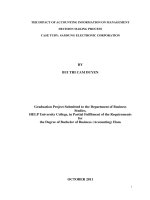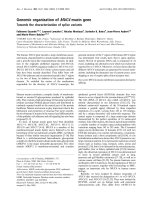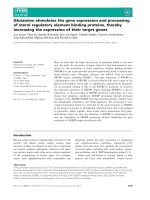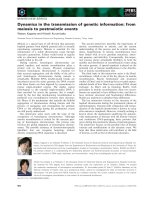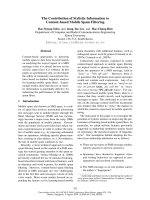GENE EXPRESSION THE FLOW OF GENETIC INFORMATION
Bạn đang xem bản rút gọn của tài liệu. Xem và tải ngay bản đầy đủ của tài liệu tại đây (1.07 MB, 35 trang )
6TH WEEK, BIO-1053
GENE EXPRESSION
THE FLOW OF GENETIC INFORMATION
6th week
General Genetics-BIO1053
Chapter outline
The genetic code
- How triplets of the four nucleotides unambiguously specify
20 amino acids, making it possible to translate information
from a nucleotide chain to a sequence of amino acids
Transcription: From DNA to RNA
Translation: From mRNA to Protein
Differences in Gene expression between prokaryotes and
eukaryotes
The effect of mutation on gene expression and gene function
6th week
General Genetics-BIO1053
The genetic code
The four nucleotides encode 20 amino acids
By deduction:
-If only one nucleotide represented an amino acid: only for 4
amino acids
-If 2 nucleotides represented each amino acid: 42=16 possible
combination of couplets (16 amino acids)
-If 3 nucleotides represented each amino acid: 43=64 possible
combination of triplets, more than enough
Must be at least triplet combination that encode for amino
acids
6th week
General Genetics-BIO1053
The genetic code
Triplet codons of
nucleotides represent
individual amino acids
61 codons represent
the 20 amino acids, 3
codons signify stop
6th week
General Genetics-BIO1053
Evidence that a codon is composed of more than one
nucleotide, Yanofsky, 1960s
Different point mutations may affect the same amino acid
• Codons must contain >1 nucleotide
Each point mutation affects only one amino acid
• Each nucleotide is part of only one codon
Evidence that a codon is composed of more than one
nucleotide, Yanofsky, 1960s
Studies of frameshift mutations showed that codons
consist of three nucleotides
F. Crick and S. Brenner (1955)
Proflavin-induced mutations in
bacteriophage T4 rIIB gene
• Intercalates into DNA
• Causes insertions and
deletions
2nd treatment with proflavin can
create a 2nd mutation that
restores wild-type function
(revertant)
• Intragenic suppression
Different sets of T4 rIIB mutations generate either a mutant
or a normal phenotype
Codons must be read in
order from a fixed
starting point
Starting point establishes a
reading frame
Intragenic supression
occurs only when wild-type
reading frame is restored
Codons consist of three nucleotides read in a defined
reading frame
Cracking the code: Discovery of mRNA
1950s, studies in eukaryotic cells
Evidence that protein synthesis takes place in cytoplasm
•Deduced from radioactive tagging of amino acids
•Implies that there must be a molecular intermediate
between genes in the nucleus and protein synthesis in the
cytoplasm
Discovery of messenger RNAs (mRNAs), molecules for
transporting genetic information
6th week
General Genetics-BIO1053
Synthetic mRNAs and in vitro translation determines
which codons designate which amino acids
1961-Marshall Nirenberg and
Heinrich Matthaei created
mRNAs and translated to
polypeptides in vitro
Polymononucleotides
Later, Har Gobind Khorana,
made polydinucleotides and
polytrinucleotides,
polytretranucleotides
-> synthesis of polypeptides
Cracking the genetic code with mini-mRNAs
Nirenberg and Leder
(1965)
Resolved
ambiguities in genetic
code
In vitro translation
with trinucleotide
synthetic mRNAs and
tRNAs charged with a
radioactive amino acid
Correlation of polarities in DNA, mRNA, and polypeptide
mARN có chiều 5’-> 3’ tương ứng với chiều đầu N-> C
của chuỗi polypheptide
Một sợi ADN khuôn
Một sợi còn lại là trình tự giống ARN
Các condon vô nghĩa gây sự kết thúc chuỗi
polypeptides, bao gồm - UAA, UAG, UGA
The genetic code: summary
The code consists of a triplet codons, each of which specifies
an amino acid
Codons are nonoverlapping
The code includes 3 stop codon: UAA, UGA, UAG that
terminate translation
The code is degenerate- more than one codon specifies the
same amino acid
Fixed starting point establishes a reading frame. AUG is
initiation codon
The genetic code: summary
5’-3’ direction of mRNA corresponds with N-terminus to Cterminus of polypeptide
Mutation modify message encoded in sequence
- Frameshift mutations change reading frame
- Missense mutations change codon of amino acid to another
one
- Nonsense mutations change a codon for an amino acids to a
stop codon
Do living cells construct polypeptides according to same
rules as in vitro experiment?
Yanofsky: Single-base substitutions can explain the altered
amino acids in trp− and trp+ revertants
Missense mutations
are single nucleotide
substitutions and
conform to the code
Proflavin treatment generates trp- mutants
Further treatment generatees trp+ revertants
Single base deletion (trp-) and an insertion causes reversion
(trp+)
The genetic code is almost, but not quite, universal
All living organisms use same basic genetics code
- Translational systems can use mRNA from another
organism to generate protein
- Comparisons of DNA and protein sequence reveal perfect
correspondence between codons and amino acids among
all organisms
Exceptional genetic codes found in ciliates and
mitochondria, for example: UAA, UAG code for glutamine
instead of stop codon; CUA specifies threonine instead of
leucine
Transcription: From DNA to RNA
RNA polymerase catalyzes transcription
Promoters are DNA sequences that provide the signal to
RNA polymerase for starting transcription
RNA polymerase adds nucleotides in 5’-to-3’ direction
• Formation of phosphodiester bonds using ribonucleotide
triphosphates (ATP, CTP, GTP, and UTP)
• Hydrolysis of bonds in NTPs provides energy for
transcription
Terminators are RNA sequences that provide the signal to
RNA polymerase for stopping transcription
6th week
General Genetics-BIO1053
Initiation: The beginning of transcription
RNA polymerase binds to promoter sequence located near beginning
of gene
• Sigma (s) factor binds to RNA polymerase ( holoenzyme)
• Region of DNA is unwound to form open promoter complex
• Phosphodiester bonds formed between first two nucleotides
6th week
General Genetics-BIO1053
Elongation: an RNA copy of the gen
σ factor separates from RNA polymerase ( core enzyme)
Core RNA polymerase loses affinity for promoter, moves in 3’-to-5’
direction on template strand
Within transcription bubble, NTPs added to 3’ end of nascent mRNA
6th week
General Genetics-BIO1053
Termination: the end of transcription
Terminators are RNA sequences that signal the end of
transcription
• Two kinds of terminators in bacteria: extrinsic (require rho factor) and
intrinsic (don’t require additional factors)
• Usually form hairpin loops (intramolecular H-bonding)
6th week
General Genetics-BIO1053
Information flow
6th week
General Genetics-BIO1053
The promoters of 10 different bacterial genes
Most promoters are upstream to the transcription start point
RNA polymerase makes strong contacts at -10 and -35
6th week
General Genetics-BIO1053
In eukaryotes, RNA is processed after transcription
Capping enzyme adds a "backward" G to the 1st nucleotide of a primary
transcript
Methyl transferase add methyl group to this G and to one or two of the
nucleotides
Transcribed
bases
6th week
General Genetics-BIO1053

